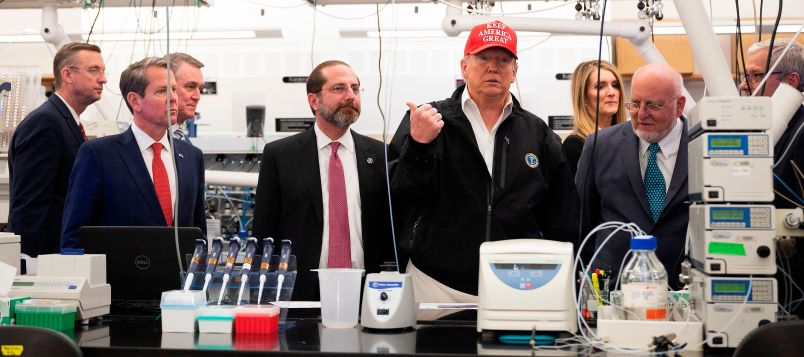Health and Human Services Secretary Alex Azar has been offering a rosy timeframe for when the COVID-19 vaccine will be widely available, but other officials working on the Pentagon-led effort to speed the virus to the public are now presenting a less optimistic forecast.
In remarks Thursday, officials from the Trump administration’s Operation Warp Speed projected that the COVID-19 vaccine would not begin to be widely available until late spring or summer.
The remarks by officials involved in the distribution effort came on a call hosted by the Association for Health Care Resource & Materials Management.
Army Col. Victor Suarez, a vaccine program manager at Operation Warp Speed, said on the call that “we want to make enough vaccine doses so that everybody who wants a vaccine in the United States can get a vaccine by this summer.”
“When vaccine becomes more plentiful in spring and summer, what you’re gonna see is more tiered groups opening up,” Suarez said at another point on the call, referring to the groups of people who the CDC has given priority to receive the vaccine, either due to the essential nature of their work or unique vulnerability to the virus.
Suarez’s remarks suggest that widespread availability of the vaccine ay not come until deeper into the summer.
Secretary Azar offered a decidedly more optimistic view on Monday, projecting widespread availability of the COVID vaccine weeks into the term of the Biden administration.
“I think we could be seeing that [vaccination of the general public] by late February going into March,” Azar told NBC on Monday. “It really, again, is going to be up to our nation’s governors, but with the Moderna and Pfizer vaccine, we’ll have, as I said, as many as 100 [million] shots in arms by the end of February.”
He added that by that time period, the COVID-19 vaccine would be as available as the seasonal flu shot.
“Late February, in the March time period, I think you’ll start seeing [it] much more like a flu vaccination campaign,” Azar said.
When asked about the discrepancy between Azar’s remarks and those of the Operation Warp Speed officials on the webinar, an HHS spokesperson told TPM that “Secretary Azar and OWS leaders have consistently stated that vaccines could become widely available, depending on the state, as early as late first quarter, with enough vaccines available for all Americans who want them by June.”
But on a call with co-panelists from vaccine distributor McKesson and BARDA, the HHS office responsible for developing medical countermeasures to emerging threats, Operation Warp Speed officials were significantly less sanguine.
“Once we clear tier 1A, B and C, and we migrate into tiers two and three, you’re going to see a lot more people have access to this vaccine,” Suarez said.
The distribution effort is currently at phase 1A, meaning that only medical workers and residents of long-term care facilities are eligible to receive the shot.
That portion of the effort is being federally run, and focuses on populations that stay in one place. But as the distribution effort continues, states will have significant leeway to decide who gets vaccinated in what order.
How fast the states go through the categories of people prioritized to receive the shot will depend on how much vaccine is available and how quickly they can vaccinate.
“We want it to be that, let’s say by the summertime, that if someone who didn’t want to get it, and now you’ve changed your mind, and you want to walk into Walgreens or CVS, we want that to be available,” Suarez added.
Also speaking on the call was Marion Whicker, a member of the Army’s senior executive service, who is deputy chief of supply, production, and distribution at Operation Warp Speed.
Whicker offered a view of availability that hewed slightly closer to Azar’s remarks, but still suggested that the secretary was being optimistic in his assessment.
She said that Pfizer and Moderna would begin supplying 20 million doses per month, each, coming out to 20 million Americans vaccinated each month at two-shot doses with maximally efficient distribution.
“By the time you get medical professionals in the first month or two, and then move on to long term care facilities, it, as you’ve probably seen on TV, we’re anticipating end of March, early end of spring, vaccines being more plentiful for all of America,” Whicker said.







Ugh. These incompetent, lying – dare I say fuckers – can’t leave government fast enough.
Well, surprise, surprise, another Trump toadie clusterfuck!! The only thing you can count on Trump’s appointees is that they take their lessons on lying from him. We probably won’t know the real situation with the vaccines until the end of January. Keep your masks and hand sanitizers handy folks, we have another year before most of this is behind us.
Warp speed?
Looks like low-grade impulse power to me.
Hey, discobot -
You may want to relook your article summary:
Spreading the virus to the public was HHS’ job. The Pentagon is handling vaccine distribution.
“Pentagon-led effort to speed the virus to the public are now presenting a less optimistic forecast”
Please correct this, not even I think they are trying to “speed the virus” to us.